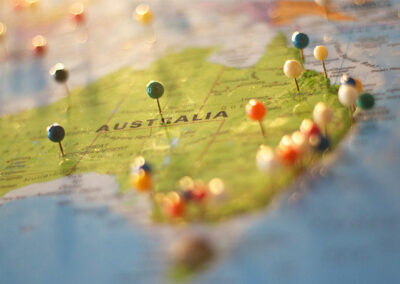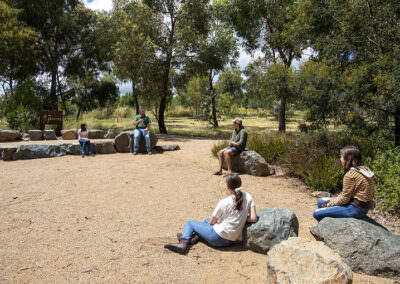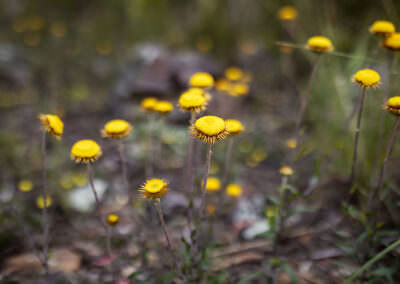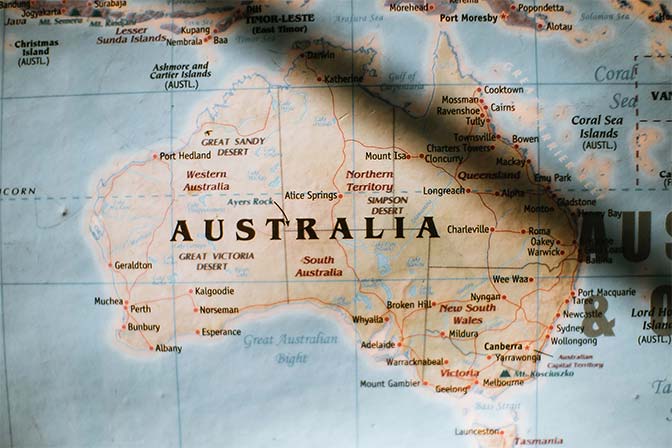LEARNING ACTIVITY
STORY
Jarrah was very excited to be invited to give a talk at his younger cousin Alira’s pre-school. Her teach thought that Alira and her friends would enjoy hearing Jarrah talk about the Indigenous plant-use garden that Jarrah and his friends had recently planted at their school.
Jarrah began his talk with an Acknowledgement of Country. Jarrah explained to the younger children that it was important for all of them to acknowledge and be thankful to the Land, and make a promise to care for the land, the waterways and all the plants and animals. The children loved hearing from Jarrah and realised that they had a lot to be thankful for. They wanted to make sure they were able to do this each day at the preschool.

This activity introduces the Aboriginal and Torres Strait Islander peoples as the First peoples of this Country, who are the traditional custodians of the lands, waterways and skies across Australia and that it is important for us to recognise that.
A Welcome to Country and an Acknowledgement of Country are opportunities for all people that show respect to Aboriginal and Torres Strait Islander peoples and cultures, and build understanding of Aboriginal and Torres Strait Islander languages and connections to Country.
Anyone can do an Acknowledgement of Country to acknowledge the country that they are on. Only an Elder from that Country can do a Welcome to Country.
Learning about Aboriginal and Torres Strait Islander languages can help children build their understanding of land, water and people. This activity helps to assist the identification of the language group/s on which the school or home is situated.
To understand local perspectives and support these activities, we recommend reaching out to the local Traditional Owners and First Nations peoples who can assist in knowledge sharing and understanding local land, histories and culture. This is an important consideration to ensure that any reconciliation initiatives are being driven in a local and meaningful way.
For children to:
- Understand that the Aboriginal and Torres Strait Islander Peoples are the traditional custodians of Australia’s land, waterways and skies.
- Learn that Australia is made up of many different communities of First Nations peoples and there is a variation between and within each group.
- Appreciate the diversity of Aboriginal and Torres Strait Islander peoples across Australia.
- Identify the language group in their local area.
This activity can be done at any time of the year.
Introduction
As children learn to acknowledge that Aboriginal and Torres Strait Islander peoples are the traditional custodians of lands, waterways and skies across Australia, it is important that they recognise that Australia is home to hundreds of many First Nations communities.
This activity introduces children to a First Nations languages map and builds understanding and appreciation of the importance of language to Aboriginal and Torres Strait Islander identity and culture.
Checklist
Instructions

STEP 1
Begin this activity at your location with an Acknowledgement of Country. By acknowledging the land, you are also making a promise that you will care for the Land, the waterways, the plants and the animals.
Using the stories, songs and videos from the reference list, help the children begin to understand that First Nations peoples are the traditional custodians of our land, waterways and skies.
What do the children know about Aboriginal and Torres Strait Islander people, culture and language? Do the children know any Aboriginal or Torres Strait Islander words? Who could we ask to find out more about local language? Use this opportunity to invite local Aboriginal and Torres Strait Islander community members and people involved in language revitalisation work to help you explore First Nations peoples culture and language for the people in your local area.

STEP 2
Use the online Gambay First Languages Map to explain the significance of language. It is important to learn which language is represented from where they live and learn.
Tell the children that each language group has an important relationship with their Country and between Countries. No part of Australia was empty or without people. Language is important for identity.
Find the location of your setting on a map of Australia. Now find that same location on the Language Map to find the name of the group where you or your home is located.

STEP 3
Take some time outside to sit quietly and listen for 2 minutes.
Explain safe and respectful behaviors and then give children the opportunity to explore for natural objects on the Country they are on. What can they find that makes them feel connected?
Children discuss what they have found on Country and what it makes them feel. Does it make them feel grateful and thankful? Does it make them feel grounded?
Remind the children of the Acknowledgement of Country that was said. at the beginning of this activity. Discuss that an Acknowledgement of Country is way of saying what we are thankful for. “We are thankful for the land, the water the plants, the animals, the people and looking after each other.” We can use this Acknowledgment of Country every day to show our thanks.

STEP 4
Using the name of the language group of your location, children complete the activity sheet to create a sign – We live, learn and play on ……. Land.
Children can decorate the sign by gluing and sticking on natural objects, or using pencils, pens or paints to decorate it. Once complete, return any leftover natural materials to the places where they came from.
Children practice reading their sign and give some examples of how they might be able to look after the Country they are on.
Explore some more local language uses with local Community Elders and use the online resources provided in the reference list to help you. Use the Welcome to Country App and search for your location on the map.
Listen to a Welcome in the local language (if available).
Extension Activity
Extension 1
When you read a book about First Nations peoples or written by a First Nations person, see if you can find where they come from (their language group) on the map.
Extension 2
Listen to the First Nations peoples language words from your location on the interactive 50 words map from the Research Unit For Indigenous language from the University of Melbourne and practice saying them.
Curriculum and Framework Links
ENGLISH
Foundation: ACELA1426
Year 1: ACELY1655, ACELA1444
Year 2: ACELA1460
GEOGRAPHY
Foundation: ACHASSK014, ACHASSK016
Year 2: ACHASSK049
HISTORY
Foundation: ACHASSK013
MATHEMATICS
Year 2: ACMMG044
CROSS CURRICULUM PRIORITY
Aboriginal and Torres Straight Islanders Histories and Cultures
Sustainability
GENERAL CAPABILITIES
Literacy
Numeracy
Critical and Creative Thinking
Personal and Social Capability
Ethical Understanding
Intercultural Understanding
THE EARLY LEARNING YEARS FRAMEWORK
Outcome 2, 4 and 5
MY TIME, OUR PLACE: FRAMEWORK FOR SCHOOL AGE CARE
Outcome 2 and 4
Reference List
The maps provided here are representations only. We encourage you to connect and consult with your local Aboriginal and Torres Strait Islander community for appropriate language advice.
ONLINE RESOURCES
The Narrgunnawali My Acknowledgement of Country (Early Learning) and Languages Map (Early Learning) activities on the Narragunnawali platform provide resources and activities on the practice of Acknowledging Country and use of Aboriginal and Torres Strait Islander language maps.
First Languages Australia is working with regional language centres nationally in the development of this Gambay – First Languages Map of Aboriginal and Torres Strait Islander languages that reflects the names and groupings favoured by community.
You can learn more about the Gambay – First Languages Map from ABC Education.
You can view the AIATSIS map of Indigenous Australia and look more closely using a magnifier to find language, tribal or nation groups of First Nations peoples.
The Languages Subject Guide on the Narragunnawali platform can provide guidance to how effectively embed ideas on reconciliation, and First Nations peoples histories, cultures and contributions, within the specific subject/learning area of Languages.
PRINTABLE RESOURCES
Aboriginal Australia Wall Map from AIATSIS (D R Horton)
APPLICATIONS
The Welcome to Country App (Apple) provides a short video Welcome to Country of a Traditional Owner or Elder.
WATCH
Choose from this selection of videos from children all around Australia singing in Language from Marrin Gamu.
Learn to count to ten in Kaurna, the language of the Kaurna people of Adelaide from ABC Education. (3 minutes)
Excerpts from Play School: Acknowledgement of Country episode including the ‘Hand in Hand’ song which gives an Acknowledgement of Country and celebrates Australia’s First Nations peoples. (1 minute 45)
LISTEN
The Little Yarns Podcast co-listening podcast series for is a listening resource for families and children to explore the diverse languages, stories and countries of Australia.
READ
Source children’s books in Aboriginal and Torres Strait Islander people’s language from Magabala Books, a publishing house owned and led by First Nations peoples.
NETWORK
We recommend reaching out to the Local Traditional Owners and First Nations peoples community groups who can assist in knowledge sharing and understanding local land, language, stories and culture.
To reach out or find contacts in your local community you could speak to parents of First Nations students, to an Indigenous Learning Officer (ILO) at your school, local Land Council or a local Landcare group. Engaging with these resources can contribute to a wider school and community reconciliation initiatives, including a schools Reconciliation Action Plan (RAP).
We have some suggested organisations to approach listed on our Junior Landcare Community page and in more detail within our Educator Notes.
Why not try one of our other Junior Landcare learning activities?
Creating an Indigenous plant-use garden: plant list
First Nations Perspectives
Creating an Indigenous plant-use garden: resources from the bush
First Nations Perspectives
Love Letters to the Land
Biodiversity|First Nations Perspectives|Food Production|Waste Management
Creating a yarning circle: involving First Nations people
First Nations Perspectives



